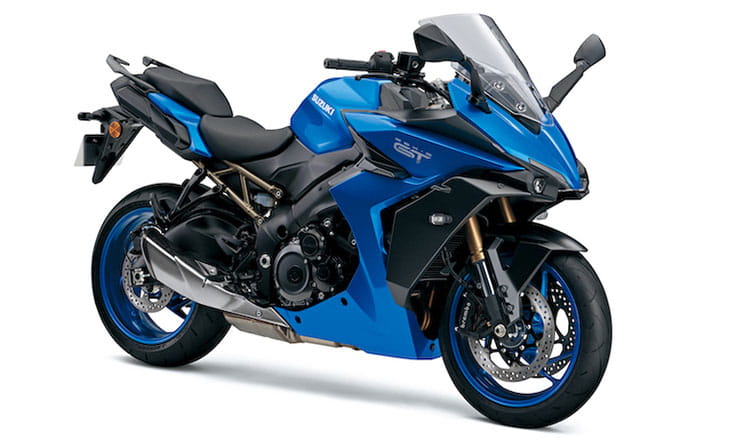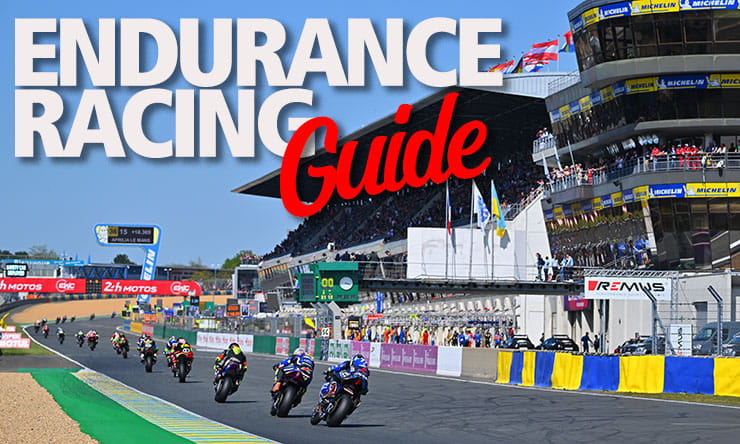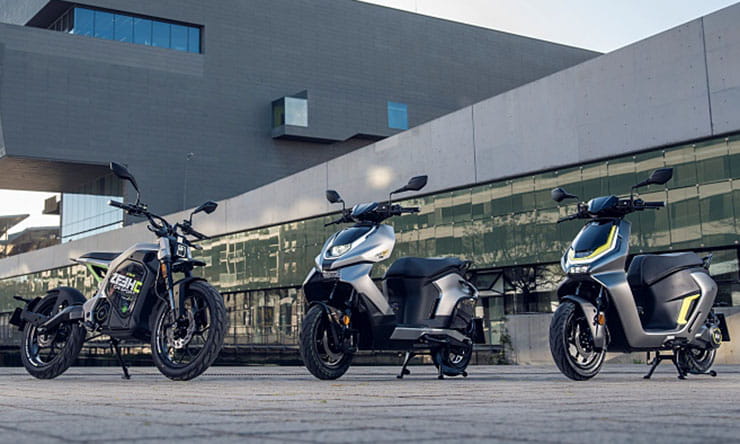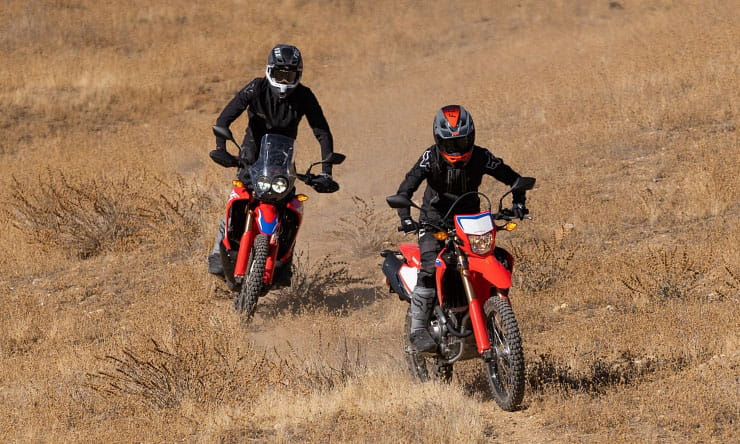Author: Frank Melling Posted: 11 Aug 2013
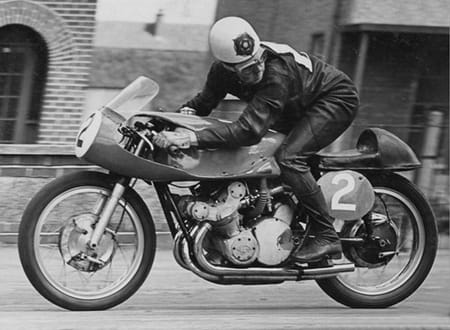
It was a big effort for my parents to find the money but for my 12th birthday I was given a Dansette record player. In the red, vinyl covered box there was a turntable and at the front a small, built in speaker controlled by knurled, plastic knobs. It was a symbol that I was growing up and ready to become part of the rock ‘n’ roll generation.
My Mum bought me the Beatles’ “I Wanna Hold Your Hand” and my avant garde older cousin gave me a quite badly scratched long play Vinyl record from the film “GI Blues” and I sang along with Elvis and “Wooden Heart” as I did my homework.
But my parents failed in their noble attempt to both civilise, and convert me into a mainstream teenager, for I had a secret sin.
No, not illegal drugs which, in my small, industrial town in the North of England, hadn’t been invented yet. Nor was it looking at partially undressed ladies in magazines which were only sold to grown ups from secret supplies under the counter.
No, my addiction had come from the second-hand shop which was located just next to the railway bridge, opposite the “Horse and Jockey” pub. In there, for the princely sum of two shillings and six pence (12 and ½ p) – a whole week’s pocket money – I purchased a well worn copy of the Stanley Schofield recordings from the 1957 TT.
And so I would go into my bedroom, close the door tight, put the Dansette under my bed sheets and in the claustrophobic darkness, listen to the wailing, siren call of Bob McIntyre winning the 1957 Golden Jubilee TT on his four cylinder Gilera.
The crackle of the British singles was the heart and body of Grand Prix racing in motorcycling’s golden era but the warbling wail of the four cylinder Gilera touched my soul.
There is an old adage that you should never, ever meet your heroes and so it is with a real sense of trepidation that I sit on Sammy Miller’s Gilera “Four” and receive a briefing from Sam’s super mechanic John Ring.
To be blunt, John is not overwhelmingly happy that I am being allowed to ride the bike. In fact, other than Sam I am the only rider to have ever been allowed to use it. World Champions, media Superstars and biking celebrities have been permitted to sit on the bike, as I have done many times in the past at bike shows and gatherings – but only with the engine cold and lifeless.
Now, John has warmed up the Gilera and I am a few minutes away from riding it.
The briefing begins. “The engine is very free revving and it will spin on until it blows up. That’s what happened in New Zealand when Sam got too enthusiastic.
Change gear at 8,500 rpm and don’t let it go anywhere near 10,000 or you will destroy it.
“Don’t let the engine go below 5,000rpm either. It will pull from nothing but the crank doesn’t like very low revs.
“Don’t be rough with the clutch. These bikes were never made for clutch starts so the clutch sits on a very shallow spline and you’ll break it if you’re rough. Don’t break it!
“Be careful with the front brake. There is a powerful self-servo effect and the front will lock in a flash.
“The rear wheel will too. Don’t lock the brakes.
“If you crash it, don’t even think about coming back…”
It’s not so much the Gilera’s £90,000 value which concerns John but rather the horrendous logistical consequences of an accident – or even a mechanical problem. You just don’t phone your local bike shop and have them ship out replacement parts for a 1957 Gilera Grand Prix bike for next day delivery.
Miller’s bike is interesting in a huge variety of ways. The absolute facts are that it is not an authentic Gilera “Four” but rather one of six replicas which were built by Mark and Dave Kay of Meccanica Verghera Engineering – somewhat ironically based in Walsall in the heart of Britain’s engineering and manufacturing Midlands.
The Kays are nothing short of genius: no other word adequately describes their ability. The two of them are probably responsible for keeping more classic race bikes on the track than any other people in the world.
Dave explains: “A customer brought us a 1952 Gilera for repair and we really liked the bike. It was one of the legendary motorcycles of all time and we enjoyed working on it.
“Later on, the same customer brought us a 1957 Gilera four which was the last model the factory produced and was the ultimate example of all Gilera’s race bikes.
“We came to an arrangement whereby we could copy the bike and make a small number of replicas.
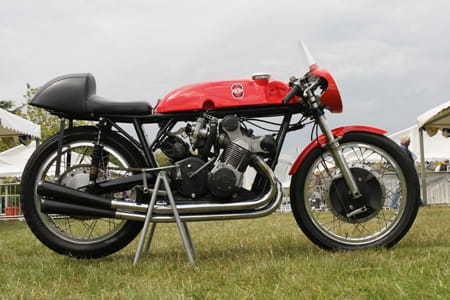
“From the start, we wanted to make a bike which was an absolute clone of the original bike. We could have easily improved it, in the same way which many British racing singles have been modernised to increase performance. But we were determined to make machines which were absolutely identical to the original bikes. This means that what was good on the original bikes is good on our machines and what is bad stays bad.
“We know we got things right because we keep a lot of the original Gileras in Italy on the track using our parts.
“Making a Gilera Four is every bit as difficult as you would imagine. The job was particularly challenging because the bike we had to copy was incomplete. We had to get inside the minds of designer Franco Passoni, and the Gilera race team, and work out what they intended to do rather than just use modern techniques to solve the questions.
“Once we understood what they had been thinking, the actual manufacturing was extremely demanding. For example, the cylinder head is a nightmare and is made in multiple parts. Through years of living with the bikes, the Gilera staff had come to understand the manufacturing tolerances.
“We had to use our experience to get things right first time and it wasn’t easy.
“As well as being exact replicas of the original bikes, we wanted them to be 100% race worthy – not just bits of dead metal to be used as ornaments.
“We achieved this aim too with Pat Sefton just failing to reach Bob McIntyre’s 100mph lap when we raced the “Four” in the 2005 Manx Grand Prix.
“That bike was sold to fund the MV Agusta project (Dave is currently manufacturing clones of Agostini’s World Championship winning three cylinder MV Agusta) but I always have a soft spot for the Gilera so I am making a new bike for myself.”
Gilera’s history of racing four cylinder machines goes all the way back to 1936 when the factory bought the rights to the CNA “Rondine” four cylinder machine. This was the first practical bike to have the cylinders transposed across the frame in the manner which, much later, the Japanese made the industry standard.
Gilera was owned, and very tightly controlled, by founder Giuseppe Gilera and he had ambitions to make his company a world leader in motorcycle design and production.
As well as being an astute businessman Gilera was a talented motorcycle racer, and mechanic, and understood the potential of the four cylinder engine – and the publicity it could bring to the Arcore factory.
Always retaining an across the frame design for cooling, the Gilera “Four” underwent many re-designs until it reach its, almost, ultimate form in Kay’s recreation of the five-speed, 1957 design which gave Bob McIntyre the 500cc World Championship.
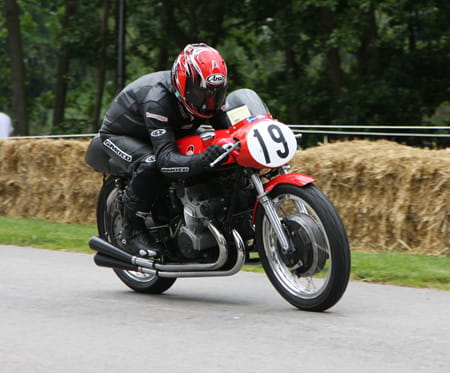
The motor was still a two-valve per cylinder design but the highly talented, and practical, Franco Passoni increased the cylinder bore to 58.8mm with two pairs of cylinder heads. There were four separate cylinder barrels and one long magnesium cam cover – and the whole lot was bolted to the crankcases via 12 long studs: all very practical if you were a Gilera mechanic in 1957 but a nightmare for the Kays to re-create.
The valves were opened by a gear train because this was considered to be the most reliable method available at the time.
Gears were also used for the primary drive to the clutch, again for reliability, and they feed the power to a five speed gearbox with the classic, right-hand side, European gear shift pattern of “one up and four down.”
A one gallon oil sump was positioned beneath the engine to help the lower the centre of gravity.
In this trim, the motor produced around 70hp and the bike weighed 150kgs (330lbs). This was 18kgs (40lbs) heavier than the best Manx Norton or Matchless G50s – but with a whopping 20hp more than the British singles.
A top quality Manx was good for around 135mph – and that was a really world class example – in contrast with the Gilera which would, in the right conditions, be nudging 155mph. Far more importantly, the Gilera would simply slaughter a Manx or G.50 in terms of acceleration.
When Geoff Duke left Norton to join Gilera he came with an intimate knowledge of the best handling race bike in the world at the time: the Norton 30M Manx.
Geoff made a number of suggestions to bring the Gilera closer to the Norton in terms of handling performance and a new frame, which lowered the engine and was shorter, became standard. This is the frame used on the Miller bike.
Also used on this bike are the formidable 220mm, double sided, four leading shoe front brake and the single sided twin leading shoe rear brake.
It’s worth exploding a myth at this point. The truth is that drum brakes can provide epic braking power when compared with a disc. The problem is that they are hugely more complex to make; much more difficult to use - and fade under severe use.
The issue with the Gilera brake is that it has a ferocious self-servo effect, Once the brake shoes bite, the rider has to ease the lever pressure to prevent the front wheel from locking uncontrollably.
With the astonishing levels of grip offered by modern classic race tyres, even an ordinary club rider of my standard can use the power of the brakes but in 1957 it must have a taken a genius to prevent them locking.
Sammy Miller issued no threats or warnings – just a smile and the instruction; “Go and enjoy yourself.”
The test track was perfect for a 1950s GP bike because it was the narrow, bumpy roads used for the Cholmondeley Pageant of Power – a very good replica of the surfaces on which GPs were run 50 years ago.
The first thing which hits me is how small is the Gilera. Maybe simply because of its reputation, or perhaps the width of those legendary four cylinders, whenever you see the bike at a show there is the feeling that it is a bulky thing. In real life, the opposite is true. It is physically smaller than the Matchless G.50 which I normally race and feels more like our much later Seeley Suzuki.
The ergonomics are superb. Everything falls to hand in the most natural way possible. The clutch is feather light and the bike just begs the rider to get down into a racing crouch. First, last and middle this is a GP bike – and there is no mistaking the fact.
John hands the Gilera over to me fully warmed up and now it’s the moment of truth. Will my mechanical hero prove to be a Disney World illusion made from re-cycled Chinese plastic?
The throttle is light and the revs soar with the merest hint of throttle. The rev. counter needle scorches anti-clockwise round the dial with worrying speed. The old adage is true: there are no atheists on the battle field. I babble a prayer under my Arai: “Please God, don’t let me wreck the bike even before the start line.”
I roll the Gilera down to the timing lights with the bike in neutral to protect the fragile clutch. Then, with no fanfare of trumpets, chariots of fire descending from the clouds or any other heavenly sign, the starting light goes green and I have an empty track and control of a legend.
The Gilera wail is much softer and more sonorous than a modern, unsilenced four cylinder engine. I bring the revs up to 5,500 and then gently ease in the clutch, so that the bike is balanced just on the edge of the power band, and then we are away.
It is impossible not to fall into the racing position and once I am on the fuel tank the bike is beautifully balanced. The gears pop in effortlessly and in seconds I am running at 9,000 rpm – the bottom edge of the GP power-band – which is 90mph through Cholmondeley’s wooded avenue.
In just a few seconds, I am at home. Rather than being some exotic monster, the Gilera is as friendly and helpful as a working Collie bitch.
Turning left at the end of the Chestnut Avenue, it takes only light pressure to get that huge front brake working and I am grateful for John’s timely advice. Again, what a dream it would be to have a brake like this in a modern classic race.
Out of the hairpin, the Gilera pulls well with the clutch in. Okay, if I were racing I would want to get into the power quicker but the motor spins up easily and we’re off again, head in the tank and trying desperately not to get near racing speeds.
Through the chicane, the Gilera’s relaxed steering makes itself known with a reluctance to flick from one angle of lean to the other but there were no chicanes in 1957 when true road racing ruled the GP world.
Downhill, and off-camber, at Chapel Bends the Gilera is rock solid and trustworthy. I catch a glimpse of the Armco on the right and for a split second imagine the consequences of getting the left-hander wrong – for me and the bike.
As every yard goes by, I get to like the bike more and more until by the end of the lap I am beginning to dream terrible, fantasy dreams.
I need two, not one, Gileras. I need one in the original trim so that on every day which is less than perfect I can go across to the workshop, crack it up and feel better about life.
I then need a second “Four” silenced to current racing levels so that I can race it hard in classic events. If the Gilera is fantastic here, ridden gently and with respect to the bike and its owner, what would it be like at Spa with the back end hanging out at 130mph?
So, if any Bennetts Social reader has a spare £200,000 to fulfil a bike junkie’s dreams, do let me know.
With many thanks to Sammy Miller for showing me greater trust than I reasonably deserve and to Pippa Lomax and the CPOP team for allowing me to use their event for this test.
And a Post Script:
I gave the bike back to John with a very real sense of relief along with the comments. “Well there we go. Back in one piece and no scratches.”
John half smiled and commented: “Yes, I know, I was watching you every inch of the way on the big screen TV.”
It was just like giving in my homework on time…
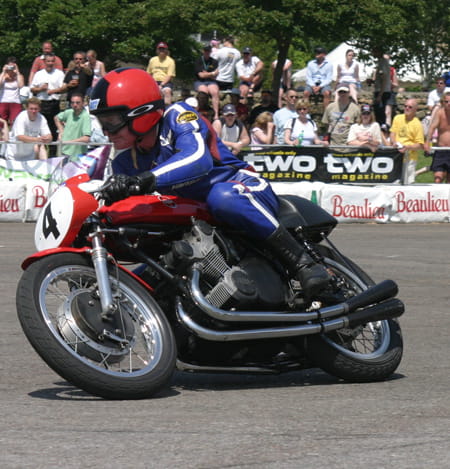
Sammy Miller
Sammy Miller is one of the great figures in motorcycle history. He was a strong candidate for World Championship road racing glory riding for the Italian FB Mondial before the factory withdrew from GP racing leaving the young Miller without a ride.
Sammy was also a brilliant trials rider and was soon a member of the Ariel factory team. With all the confidence and courage of youth, the young Ulsterman relocated to Birmingham, which in 1957 was the heart of the world motorcycle industry, to join Ariel as an employee. There he developed Ariel’s aging 500cc single cylinder bike into the world’s best trials machine.
Bultaco recognised his brilliance not only as trials rider but also as one of the most free thinking development engineers of his generation. Miller quite literally designed the Bultaco Sherpa from scratch and this 250cc two-stroke was to become a huge success throughout the world for the small Spanish factory.
As Bultaco began to struggle against the ever fiercer Japanese opposition Miller was head hunted again – this time by Honda.
Although still a brilliant rider, Sammy now took on three roles as rider, Honda factory team manager and development designer – and excelled in all three.
Honda went on to dominate trials for fourteen outstanding years.
However, there was a glitch in the Miller success story. Honda’s vision was that trials would take the American motorcycling scene by storm. They produced superb, easy to ride bikes and Miller promoted trials on American tours – but all to no avail. Americans never did take to trials in a serious way and eventually Honda lost interest.
Sammy was also a very successful motorcycle dealer and manufacturer of specialist parts for trials bikes.
In parallel with this business, Sammy became a collector of motorcycles, at first just to fuel his passion for bikes but now into a yet another full time, world leading business.
“It started with a few bikes I really liked and fancied owning but I soon needed a bigger garage. Eventually, in 1996, the museum was born and we now have over 325 machines in one of the world’s best collections of exotic bikes.”
Sam’s contributions to motorcycling were recognised by the Queen when she made Miller a “Member of the British Empire” in 2009 - one of the very few motorcyclists to receive this high honour.
Now, Sammy Miller MBE is a mainstay of the classic motorcycling scene, demonstrating his iconic race bikes throughout the world.






